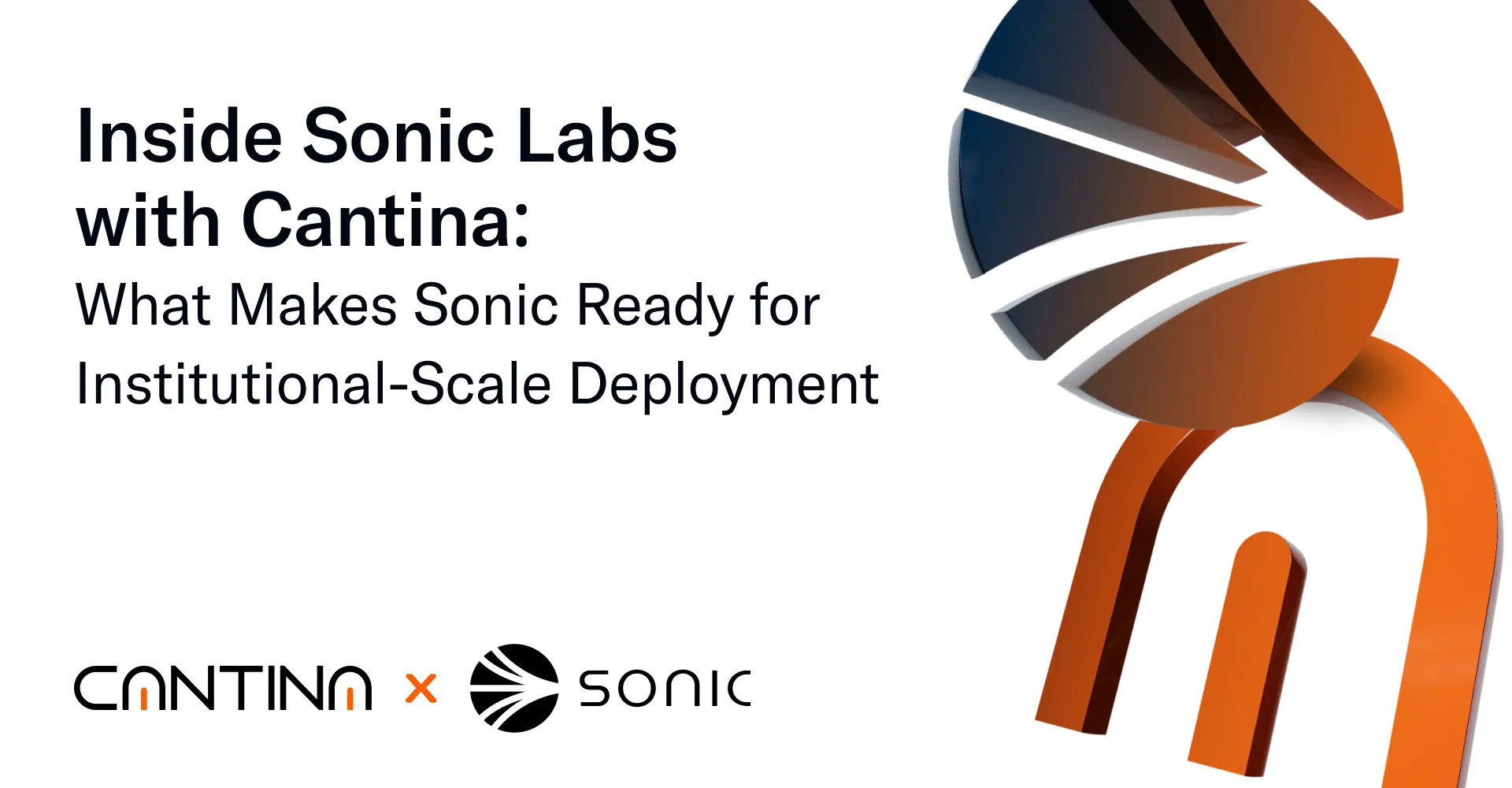Sonic is quickly establishing itself as one of the most performant EVM Layer 1 blockchains in Web3, engineered to support the next generation of decentralized applications through speed, efficiency, and aligned developer incentives. With over 400,000 transactions per second and sub-second finality, it offers execution performance on par with traditional finance infrastructure, without compromising on EVM compatibility or decentralization.
As part of this trajectory, we were glad to collaborate with the Sonic Labs team on key security components, contributing to their efforts to deliver a resilient, high-performance platform. Below, we break down the technical architecture, enterprise capabilities, and operational frameworks that make Sonic an infrastructure layer to watch.
Infrastructure Overview
Sonic delivers advanced performance through multiple architectural components:
- SonicVM provides EVM-compatible execution for Solidity and Vyper, supporting fast, safe contract performance.
- SonicDB supports fast and efficient data storage using specialized nodes for validators, RPC providers, and observers.
- Sonic Gateway enables secure cross-chain transfers between Ethereum and Sonic with sub-second finality, immutable fail-safe mechanisms, and optional fast-lane bridging.
- Fee Monetization allows developers to earn 90 percent of network fees generated by their applications.
Sonic integrates with widely-spread Web3 developer infrastructure including Chainlink, Safe, Pyth, Alchemy, and more. This ensures out-of-the-box compatibility for teams using existing oracle feeds, contract libraries, and wallet tooling.
The network’s specialized node architecture includes dedicated roles for validators, RPC providers, and observers, optimizing for low-latency performance and infrastructure flexibility.
The full documentation is available on Sonic's website.
Enterprise Capabilities
Sonic infrastructure supports a range of enterprise applications:
- Sub-second transaction finality supports real-time finance, foreign exchange, and payment flows.
- EVM compatibility enables reuse of existing security models and deployment frameworks.
- High throughput supports use cases with large transaction volume including retail DeFi, settlements, or liquidity provisioning.
- Secure native bridging ensures operational continuity with recovery paths for asset transfers.
- The Sonic Gateway supports deterministic bridging with 10-minute heartbeats from Ethereum to Sonic and an immutable 14-day fail-safe mechanism that ensures users can reclaim assets in case of disruption.
Institutional Readiness
Sonic’s governance and token model support its enterprise direction. Token supply proposals have allocated over 300 million S tokens to pursue initiatives such as an ETF, Nasdaq DAT, and U.S. capital markets expansion. Sonic USA was established to serve these goals. Tokenomics include defined issuance caps, burn mechanisms, and funding limits designed to prevent inflation.
Teams can deploy to Sonic using standard developer tools like Foundry and Hardhat. Infrastructure is preconfigured with RPC access, explorers, and support for wallets such as MetaMask, Rabby, Fordefi, and Fireblocks. Validator operations and modular infrastructure offer flexibility for custom deployment.
The network’s emissions schedule includes capped issuance for growth programs and a burn mechanism for unused tokens, preventing long-term inflation. Validator rewards are structured to scale proportionally with network participation, targeting a 3.5% APR when 50% of tokens are staked.
Security Collaboration
Cantina conducted security audits of Sonic’s airdrop contract system, which included budget-constrained market orders, segment updates, and token claim logic. This audit reflects the shared priority of securing infrastructure components that underpin key user flows.
Use Cases of the S Token Within the Ecosystem
The S token supports multiple utility functions across the Sonic ecosystem. It is used for governance participation, protocol voting, and treasury allocation. Users can stake S tokens to secure the network, operate validator infrastructure, and earn protocol rewards.
The token facilitates financial operations such as transaction fees, liquidity mining, lending, and integration into DeFi products. It enables access to airdrops, bridging, and other network services.
By powering economic coordination, the S token supports growth, activity, and governance in the Sonic ecosystem.
Financial Recovery
Sonic Labs has committed over seven million dollars toward recovery efforts related to the Multichain incident. This includes five million dollars for legal work and two million dollars allocated by the foundation for continued actions in the United States and China.
This financial commitment highlights the resources required to resolve complex security events. Comparable events in the industry, including the FTX bankruptcy, have incurred legal costs exceeding five hundred million dollars. Sonic’s investment aligns with its responsibility to users and pursuit of cross-jurisdictional asset recovery.
Strategy and Risk Framework
The Multichain recovery approach demonstrates Sonic Labs’ operational strategy in responding to high-impact incidents. Compared to extended bankruptcy timelines or irreversible losses, this proactive effort provides a roadmap for user protection and financial restitution.
Comparable actions by protocols such as Venus, which recovered over $30Mdollars using emergency governance, show that recovery is achievable with the right structure. Sonic’s actions position it as a leader in incident response and cross-chain risk management.
Market Considerations
Sonic’s legal and financial recovery program underscores the cost of security breaches in DeFi. It also reinforces trust in organizations that invest directly in remediation and user protection.
This response model may serve as a reference point for other Layer 1 networks and applications managing cross-chain risk, protocol vulnerabilities, or third-party dependencies.
Looking Ahead
Sonic continues to demonstrate that high-performance blockchain infrastructure can meet the needs of enterprise-grade applications while remaining accessible to the broader developer ecosystem. Its architecture, economic model, and operational footprint reflect a deliberate design to support scalable decentralized systems with institutional requirements in mind.
Cantina believes that enterprise-grade blockchain systems require rigorous validation, resilient infrastructure, and proactive recovery planning. Our collaboration with Sonic reflects our shared commitment to scalable, secure, and developer-ready networks.
If you are building on Sonic or deploying high-throughput applications requiring formal security coverage, contact Cantina to scope an engagement. Our offerings include protocol audits, incident response planning, tabletop simulations, and economic stress testing.




